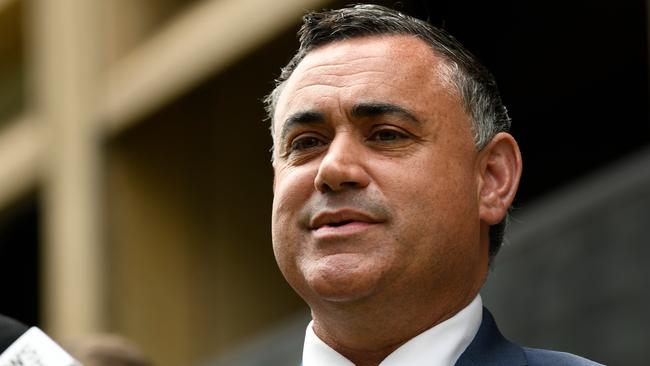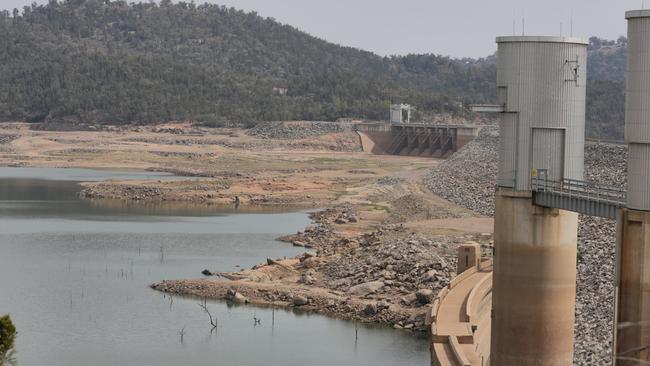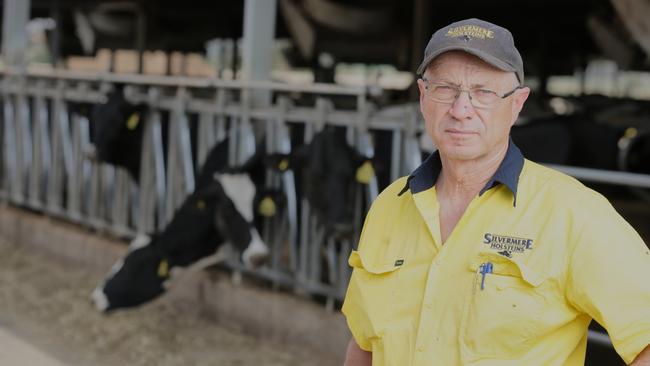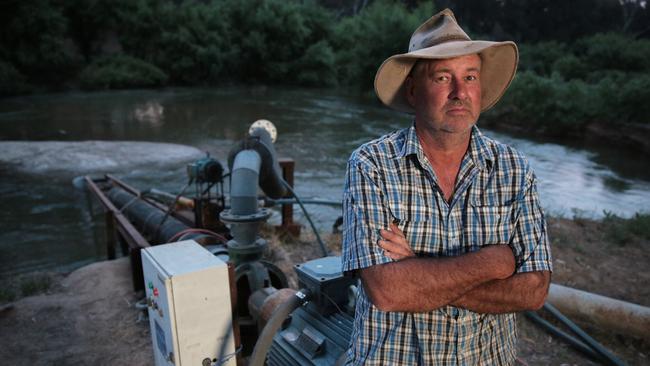Deputy Premier John Barilaro calls for NSW to abandon Murray Darling Basin Plan
Deputy Premier John Barilaro has called for environmental flows and the Murray Darling Basin Plan to be stopped immediately after drought-stricken towns watched billions of litres of dam water flushed into swamps.
NSW
Don't miss out on the headlines from NSW. Followed categories will be added to My News.
Deputy Premier John Barilaro has called for environmental flows and the Murray Darling Basin Plan to be stopped immediately so people in regional communities can be prioritised over “flora and fauna”.
The leader of the NSW Nationals also blamed “green ideology” for stopping the construction of dams in regional areas and said the drought was making communities desperate.
“In the midst of the worst drought you should pause all your water sharing plans … we should pause the Murray Darling Basin Plan and we need to put people before the environment,” Mr Barilaro told a Budget Estimates hearing.

MORE NEWS
Revealed: Secret police files from Pulver ‘collar bomb’ case
Sam Burgess charged with domestic violence offence
Can Parramatta avoid Kings Cross fate as night-life booms?
“I’m sorry, but we’ll have to rehabilitate those environmental issues when the time comes, if the water comes.
“I do accept that environmental flows is really, really upsetting so many irrigators, farmers, and communities because it seems that we put flora and fauna in front of people,” he said.
“The threatened species I worry about is actually regional and rural people, and the priority has now got to be people and communities.”
Mr Barilaro said the federal government was currently assessing the Murray Darling Basin Plan, with a final report to be published in December or January.

“At the end of this review…If we can’t see a change in how the Murray Darling Basin Plan is working for NSW – forget pausing the plan – rip the bloody thing up and we’ll walk away,” he said.
“We should be pausing all water sharing plans at this time – why – because we have got to put people first.”
Mr Barilaro said no new large scale dams had been built in NSW over the past 30 years.
“We have allowed green ideology and the balance of power they have had in houses of parliament to stop us building dams and that is what has caused a big part of this (problem with water),” he said.

The news comes after thousands of residents of drought-stricken NSW towns and struggling farmers watched in horror as federal bureaucrats flushed 22 billion litres of water down a dwindling river system to land in swamplands.
The critical Wyangala Dam’s already low storage level has plunged by 20 per cent just weeks after the water release.
NSW Water Minister Melinda Pavey said last night the water released from the dam down the Lachlan River on orders from the independent Commonwealth Environment Water Holder was enough to supply the population of the towns of Cowra, Condobolin, Lake Cargelligo and Forbes for over a year.
The CEWH — an independent Commonwealth agency charged with irrigating river streams — told the state body Water NSW to release the 22 gigalitres from mid-September to help the parched river system.
Water NSW complied and the water was sent on its 1000km journey down the Lachlan River where it will sink into the Great Cumbung Swamp in the state’s southwest. That supply could have sustained the population of those drought ravaged towns — somewhere between 20,000 and 30,000 people for at least a year — which face the real prospect of running dry.

A furious Ms Pavey said last night: “I would like to see evidence that this was the best time to release water for the environment when the Bureau of Meteorology is indicating little to no inflows over the next 12 months.”
She added: “Even swamps suffer drought.”
A spokesman for the CEWH said yesterday the water had “provided critical flows throughout the length of the Lachlan to improve the health of the river system and make it more resilient in the face of possible ongoing drought conditions”.
One senior source from the green agency cited catfish, crayfish and freshwater shrimp as important beneficiaries of the environmental decision. They also insisted state bodies and local figures had been consulted on the release of the water.
But Ms Pavey accused the agency of “blind recklessness”.
“Over the past year the Lachlan Valley has experienced 8.8 per cent of the average inflows — 107 gigalitres instead of the average 1212 gigalitres,” she said.
“During times of extreme drought, we need flexibility, not blind recklessness.
“Farmers have been blamed for a lot while the CEWH continues to pour water down the river without any regard for our communities doing it tough.”

Federal Environment Minister Sussan Ley said the releases were “co-ordinated with state authorities”.
“I am assured that the level of co-ordination is such that along the Lachlan, both Commonwealth and state environmental water reserves are jointly managed and all flows mutually agreed after community and specialist input,” she said.
Ms Ley added that as the drought deepens, it was crucial authorities “all work together to consider the trigger points at which water is identified for critical human needs”.
The Wyangala Dam is at critically low levels. It was at 23 per cent capacity at the start of September and has now dropped to just over 18 per cent — a decrease of about 20 per cent.
The state government had already limited access to all general water entitlements to 57 per cent this year, restricting the volumes irrigators and the CEWH could access in the face of the drought.

The CEWH is an independent statutory office holder established under the Commonwealth Water Act and was within its rights to flush its water allocation down the river to help the river system.
However, the water legislation does not require the head of CEWH to release the water. The head of the body makes the release by placing an “order” with Water NSW, who then pull the lever.
Neither Ms Ley or Ms Pavey can direct the head of CEWH to act in contravention of the Commonwealth water legislation.

Cowra Mayor Bill West said there was “a great deal of concern (about the release) in this time of drought”.
“It’s understood that the river has to be operated in accordance with the legislation but at the time of drought and concern about critical human needs there needs to be some reconsideration about the impact environmental flows may have,” he said. “The amount of water that rushed past Cowra in a day would have supplied the town for a year.”
Cowra dairy farmer Colin Thompson said there should be a “moratorium on environmental flows in this crisis”.

He said government agencies had “pulled the plug out on the water” without demonstrating benefits for drought-stricken farmers.
“Environmentalists are kicking up a storm saying the water is theirs so they can do what they want,” he said. “It is theirs under the plan but they must do the right thing.”
Cowra merino sheep farmer Richard Chalker said he could not understand releasing water at this time.
“It just seems like a waste. It’s OK to send some down if it helps other farmers down the river but we need to be so careful.”
